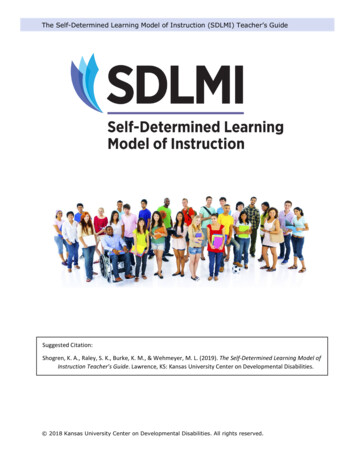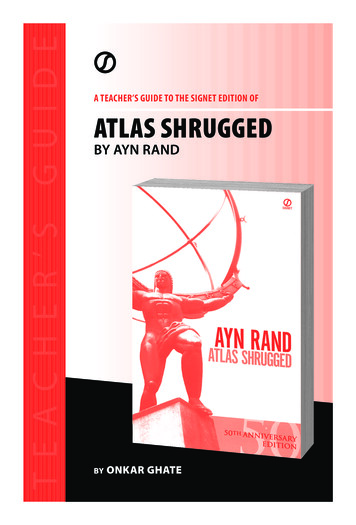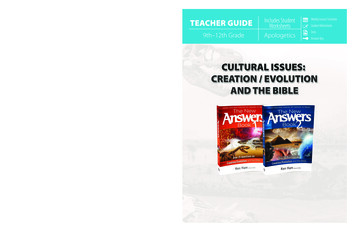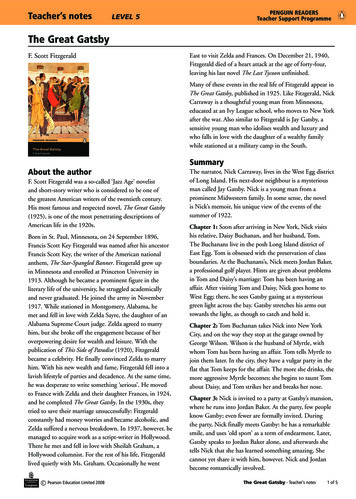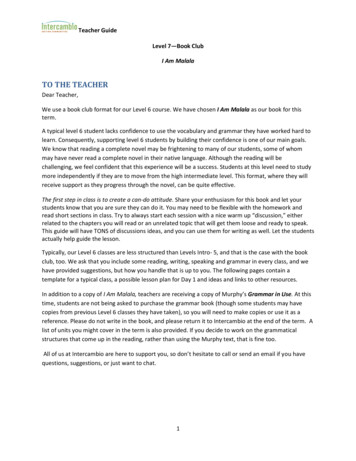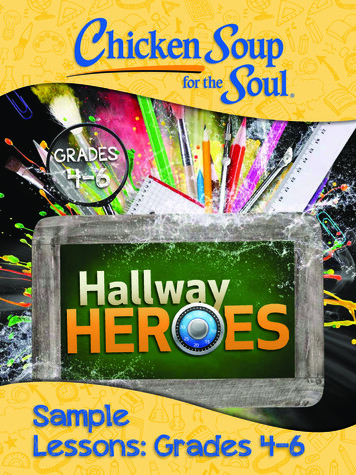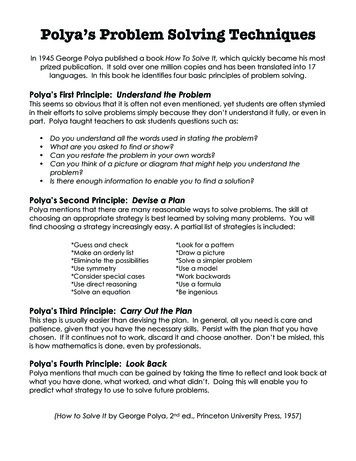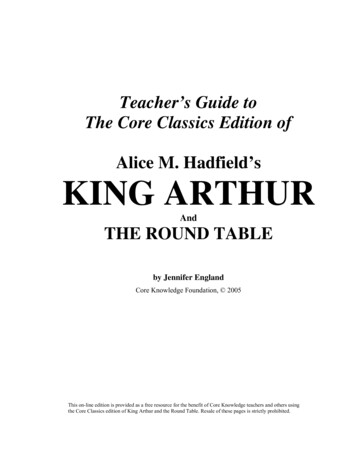
Transcription
Teacher’s Guide toThe Core Classics Edition ofAlice M. Hadfield’sKING ARTHURAndTHE ROUND TABLEby Jennifer EnglandCore Knowledge Foundation, 2005This on-line edition is provided as a free resource for the benefit of Core Knowledge teachers and others usingthe Core Classics edition of King Arthur and the Round Table. Resale of these pages is strictly prohibited.
Table of ContentsIntroduction - King Arthur, Man or Myth? . 3Teaching Notes . 7Chapter SummariesPart I: Chapters 1–5 . 10Part II: Chapter 6–8 . 14Part III: Chapters 9–15 . 17Part IV: Chapters 16–22 . 21Student ActivitiesPart I . 26Part II . 38Part III. 46Part IV. 58Culminating Activities. 68Teacher Answer Guide . 69AppendixImportant Sites. 83Who’s Who. 84Semantic Word Map. 89Map of Arthur’s Britain. 90Bibliography . 912
“As the hero of Malory’s story, Arthur tries to rule fairly in peace andprosperity. He enlists the best fighters in Briton to join the fellowship ofthe Round Table For the sake of those suffering under justice, they facedanger alone to enforce the law and punish the wicked The quest sets ahundred knights roaming the roads of Britain, seeking something invisibleto them. Chivalry, putting its trust in the survival of the fittest, requires aknight to look for action and to put himself at the mercy of chance. Thedeath-defying heroes of the Round Table hurl themselves into singlecombat with unknown foes at an instant Camelot's bonds ofbrotherhood, eaten at by greed and jealousy, unravel into civil war. Thespirit of revenge hacks away the body of the Round Table Badlywounded in combat, Arthur is taken for healing to Avalon, the island inCeltic myth, where the dead go Yet for a time, justice and goodness,order and peace reign from Camelot ”Excerpts from the Introduction of King Arthur by E.D. Hirsch, Jr.Introduction: King Arthur, Man or Myth?For the past fifteen hundred years, stories of a legendary king and his court have come tosymbolize all that is noble and good. The story of King Arthur and his knights is the tale of atime of peace, justice, and brotherhood. It is the story of Knights, living by a Code of Chivalry,who created briefly an ideal world based on honor and good deeds. It is the story that ends inbetrayal and tragedy, but it leaves us with the hope that another such time might come again.Sources for the Arthurian LegendsLe Morte d’Arthur is the source of the Arthurian legend used in the Core Knowledge Classic,King Arthur and the Round Table, adapted by Alice M. Hadfield. Le Morte d’Arthur is based ona collection of stories written by Sir Thomas Malory and edited and printed by William Caxtonin 1485.Until a few years ago Le Morte d’Arthur's author, Thomas Malory, was little known. It isprobable that he was Sir Thomas Malory, born about 1400 of an old Warwickshire family. Heloved hunting, tournaments, and chivalry and was well versed in the Arthurian romance of hisday. He spent much of his life in prison, some say because he was a violent man; others saybecause he was a politically unpopular one.In either case, his days in prison allowed him theopportunity to pen his classic.Originally his work was called The Book of King Arthur and His Noble Knights of the RoundTable. Based on assorted tales, the book was a compilation of beautifully written French andEnglish stories, put together without great skill. Malory’s Arthur may have been forgotten had itnot been for William Caxton, who effectively reorganized and edited Malory’s tales into LeMorte d’Arthur.Born in Kent in 1422, William Caxton was England’s first printer. He produced 100 books andpamphlets including The Canterbury Tales. Many were his own translations and contained hisown prefaces. He published only what he thought was the best writing of his day. He is knownfor shaping and standardizing the English language. He thought the knights of his day were un3
Arthurian so he published the Order of Chivalry to accompany Le Morte d’Arthur giving Malorycredit as the author. This 1485 Malory edition has become the definitive version of King Arthurand his Knights of the Round Table.Historical Model and Historical Context of Arthur’s StoryWho was the model for Malory’s chivalrous Arthur? Was it the Earl of Warwick he served underin the French Wars and man whom all of Europe recognized as embodying the knightly ideal ofthe age? Or did Malory’s enthusiasm for chivalry come from the English king at the time, HenryV, whose feats were similar to Malory’s Arthur? We’ll never know. But we do know much ofMalory’s story was based on previous writings – mainly those of Geoffrey of Monmouth.Geoffrey of Monmouth became the first and one of the most important authors of Arthurianlegends. Three of his works survive today: Prophecies of Merlin, Historia Regum Britanniae,and Life of Merlin.We know little of his personal history. His full name seems to have beenGeoffrey Arthur — Arthur being the name of his father. He was educated at the priory inMonmouth and was consecrated bishop in 1152. He died in 1155.In 1136 Geoffrey began writing his Historia Regum Britanniae (History of the Kings of Britain).He claims to have used an ancient book, the British Book, containing authentic historicaldocuments. Through his life in the monastery, he became familiar with Welsh and Bretonfolklore, which founds its way into his history.In the first chapters of The Historia, Geoffrey traced the origin of Britain, telling of legendaryand actual events. The Arthurian portion is the climax of the Historia. The Celtic victory overthe Saxons was followed by a “Golden Age” of peace during which Arthur established thefellowship of Knights. The Saxons eventually overpowered the Britons who retreated into Wales.The Historia ends in 689 with Merlin’s prophecy of a return to power by the Celts.Fusing the popular stories about Arthur with the few documents he had access to, Geoffrey founda way to satisfy the courtly readers of his day. Romance was in demand; Geoffrey modernizedArthur’s court to accomodate 12th century customs. His sources probably included Gildas TheWise (504–570) a sixth century monk who wrote “Concerning the Ruin of Britain” — writtenreferences to an Arthurian figure begin with his work — and Nennius, a Welsh monk who wroteabout AD 800.Nennius was the first to refer to Arthur. In his Historia Brittonum, Nennius, describing Arthur’sgreat victories over the Saxons said, “The twelfth was the battle at Mount Badon, in which, onone day, nine hundred and sixty men fell to the ground during one onset of Arthur; and no oneoverthrew them save himself alone; and in all the battles he emerged the victor.”At the time it was written, The Historia was accepted as a true record of the Welsh from 1100BC to AD 689. Geoffrey brought us Merlin’s magic, Arthur’s marriage to Guenevere, Uther andIgraine, the castle of Tintagel and Mordred’s betrayal as part of the Arthurian legend. Camelotand Lancelot did not appear in this text. In 1150, hundreds of copies of his manuscript — to thatdate the most produced of one manuscript — spread throughout Europe and stimulated theromantics, who added even more to the legend. In 1155, Wace, a French writer, used Geoffrey’schronicles as inspiration for his poetry. He introduced the Round Table and the notion thatArthur would live again.4
The French Romantics and Their InfluenceIn the 12th through 15th centuries, French romance writers influenced the image of knights, whatthey wore, and how they fought. Chivalry, tournaments, jousts, entertainment, and courtly lovewere incorporated into the Arthurian legend. Chretien de Troyes was probably the greatest ofthese writers. Between 1160 and 1172, he lived as herald-at-arms at Troyes. His patroness wasCountess Marie de Champagne, daughter of Louis VII and Eleanor of Aquitaine. He wrote fourromances about the ideals of French chivalry, including Perceval the Welshman and Lancelot orThe Knight of the Cart. He is the first to mention a Camelot in his poem of Lancelot.The telling of Arthur’s story did not end in the Middle Ages. Alfred Lord Tennyson’s Idylls ofthe King and Mark Twain’s A Connecticut Yankee in King Arthur’s Court kept interest alive inthe 19th century as did T. H. White’s The Once and Future King in the 20th century. And theinterest continues today, both in books and film.We know much of the story is fiction. But was there a King Arthur? There is no proof positivefor an historical Arthur in the 5th and 6th centuries. No texts survive that mention him by name.But archaeological evidence shows an unusual period of comparative peace in the early 6thcentury — a time similar to that described in the legends of Arthur that have been passed downthrough the generations.Whether or not a real Arthur existed, the Arthur of literature is one we care about. People needheroes, so legends are told and retold. Knights, living by a Code of Chivalry, inspire the worldwith their honor and good deeds, serving together in the great fellowship of the Round Table.The notion of an ideal king is pieced together over the centuries and writers shape the legend tosuit their time.Is there a real person buried under the layers of romantic fiction? Historians continue the searchfor the real Arthur.Medieval Background of the King Arthur LegendTo understand the “great misery of Britain” when there was no true king, students needknowledge of the warlike tribes attacking the Roman Empire, sacking Rome, and taking land.The Angles, Saxons, Huns, Vandals, Goths, and Franks split the Roman Empire into Westernand Eastern sections. In this period of “Dark Ages,” beginning about AD 450, Britain had noking or emperor. The British Isles were in turmoil. The people longed for a leader to protect thepoor and keep justice.By AD 476, many of the tribes had converted to Christianity and adopted the religion andcustoms of Rome. The Bishop of Rome (the Pope) had become the most important Churchofficial whose power extended beyond church affairs. European monks lived as hermits or inmonasteries isolated from the world. But St. Benedict’s reforms encouraged monks to worktogether, to spread Christianity, and to help the poor. Benedictine rules influenced other types ofmonasteries and convents so that religion had a great impact on the daily life of people as well asthe liturgy of the Church. Gregorian chant, beloved by Benedict, became the official music of theCatholic Church.5
With the advance of Christianity, the reverence for the Holy Grail, thought to be the cup used byJesus at the Last Supper, and other relics spread across Europe. The Quest for the Holy Grailinspired hundreds of knights to search for heavenly objects that only the holy and pure couldfind. This spiritual journey can be better understood when students realize that in the middle agesearthly life was seen as a battle between heaven and hell. In this age of faith, belief in miraclesprevailed, and witchcraft and magic were used to test truth and loyalty.In 800 A.D., Charlemagne was crowned Holy Roman Emperor, the first emperor since 476.During his reign the empire expanded, Christianity spread, education and culture wereencouraged, and communication and travel were improved.Feudalism, a social system based on loyalty, developed. Kings needed warriors to fight for them;the warriors (vassals) needed land. The vassal swore to fight for the king, and the king pledged toprotect his vassal. The feudal agreement was made in a church ceremony with the vassal payinghomage to his king. The oath of fealty bound the king to his lords, the lords to their vassals, andthe vassals to dukes and knights. This sacred oath was respected throughout Europe. If a vassalfailed to serve his lord, he became an outlaw, persecuted by other lords.Knights of the Round Table lived by a code of chivalry built on courage, honor, and respect. Inthe fellowship of the Round Table, all were treated equally. Loyalty was owed to God and King.Truth and love were seen as worth dying for. For students, knowledge of knighthood andtournament games provides the background for understanding the pageantry and celebrations atCamelot. Familiarity with heraldry helps them understand the tragedy of brother slaying brotherwhen each carries a shield without his own device as in the case with Balan and Balin in Chapterfour.6
Teaching Notes for King ArthurAn OverviewTravel with King Arthur, Lancelot, and Galahad to the magical kingdom of Camelot — a timewhen church, loyalty, and chivalry guided daily life. Building on students’ backgroundknowledge of Europe in the Middle Ages, explore the fellowship of the Round Table. Discussthe legend as a literary piece, emphasizing story elements and stylistic techniques. Analyzecharacters and motivations as you incorporate grammar, vocabulary, and writing into your study.King Arthur is an exciting but challenging book for fourth graders. As the teacher, it is criticalthat you read this classic before introducing it to your students. For full benefit and enjoyment,King Arthur should be read aloud with ample opportunity for students to discuss and makeconnections together. Students will thrill to the adventures of the Quest, marvel at the vows ofcourage and loyalty that Knights uphold, and feel the sadness of a friendship that ends tragically.After students in my classroom were familiar with the stages of knighthood, we began “TheQuest to Become a Knight of the Round Table.” This was a fun way to integrate stages ofknighthood with classroom expectations. As a page, each student had to demonstrate basicclassroom behaviors and expectations related to doing homework, following directions,completing daily work, etc. When they had earned 25 points, they advanced to the Squire’sChallenge. The challenge required them to demonstrate “knight-like” behaviors outside of theclassroom and at home. For example, they had to identify a time when they were brave andhonorable, protected women and children, gave help to those in trouble, etc. An adult signed as awitness to each deed. A list, posted in the room, was updated as students moved from Page toSquire and then to Knight. Note that this activity is suggested as choice 4 on page 35.King Arthur is divided into four parts: The Founding of the Round Table; The Round Table inAction; The Quest of the Grail; and The End of the Round Table. Each of these four partscontains three to seven chapters. I have designed the Teacher’s Guide around these fourdivisions. Each chapter of the Guide includes a brief summary for the teacher and a list of majorcharacters. For students, each chapter lists the new characters and their relationship. Also studentvocabulary and study questions are provided. At the end of each part, I have included acumulative vocabulary activity and suggested writing, art, and drama activities.Integrating HistoryAs you will see, many topics from the fourth grade Core Knowledge sequence are integrated intothis literature unit. Foremost, of course, are those from the World History and Geographystrand. A great resource for teaching this background knowledge is the Pearson Learning Historyand Geography book, Europe in the Middle Ages, chapters one through nine. This Core contentshould be taught prior to or in conjunction with the reading of King Arthur.7
Integrating Language Arts and the Study of LiteratureAs active readers, students should practice skills of questioning, connecting, predicting,reviewing and evaluating. They should delve into the story to discover literary elements ofsetting, plot, character, and theme. They should develop an awareness of literary techniques suchas personification, description, similes, metaphors, foreshadowing, and symbolism.Using examples from the text, a variety of Language Arts skills in writing, grammar and usagecan be taught. Among the grammar skills are activities to identify types of sentences, concreteand abstract nouns, and parts of speech. Include a discussion of Proverbs to provide anopportunity for students to explain the motivation and behavior of different characters. “Twowrongs don’t make a right” fits nicely in Chapter 4 when Balin, the Savage seeks revenge. “Thebigger they are, the harder they fall” helps explain Merlin’s folly and demise in chapter 8.Vocabulary activities use context clues and dictionary entries to determine meaning. Sentences,copied from the text of the book, focus on three to five words per chapter. Scaffolding techniquesare used to help students figure out word meaning. Graphic organizers, such as word maps,extend meaning by encouraging students to find specific examples from the book. Dictionary useis also included. Students determine how many entries are listed for each word; the best meaningfor the word in the given sentence; the part of speech; and synonyms or antonyms. We did thevocabulary activities together before reading the chapters.Both narrative and expository writing activities are included as suggestions. Ideas for personalletters, quest journals, and poetry are presented. Using the accordion paragraph format, studentscan organize material with topic sentence, examples and details, and a conclusion.Integrating Music and the Visual ArtsA study of illuminated manuscripts, stained glass windows, and Gregorian chant from VisualArts and Music topics in the Core Knowledge Sequence fits nicely with the study of King Arthur.Culminating ActivitiesSuggested culminating activities can involve many skills and many subjects. My suggestionsinclude: Round Table reenactments; role-playing the taking of a fealty oath and the dubbing of aknight; sponsoring a medieval banquet or medieval trade faire. The banquet or faire couldhighlight knighting ceremonies, as well as music and art, as part of the event. There is no end ofpossibilities for culminating activities and you may want to add some of your own devising.Study AidsTo minimize the confusion of people and places mentioned in King Arthur, I have developedadditional resources. A map of Arthur’s Britain will give students a general idea of setting andlocation. A Who’s Who identifies the major characters and their relationships. In addition, thereis a detailed list of all characters for teacher reference at the end of the guide. A listing ofimportant sites can be enlarged and posted in the room. The word map template can be copiedand used for any concept or subject (electricity, trade in China, chivalry, hero, etc.)8
Chapter SummariesPart I: The Founding of the Round TableChapter 1: The Birth of ArthurUther Pendragon fights not only against invaders but against his own subjects, one of whom isthe Duke of Cornwall. Wishing to make peace, Uther invites the Duke to his palace. The Dukebrings his beautiful wife, Igraine. A peace treaty is made. Uther falls in love with Igraine.Realizing this, Igraine asks her husband to take her back to their castle at Tintagel. Utherprepares to make war and follows the Duke to another castle at Terrabil. Out of anger and love,he becomes ill and sends for Merlin. Merlin tells Uther that he will marry Igraine and they willhave a son. The son must be given to Merlin to raise. After Uther agrees, Merlin tells him whatto do. So the King rides toward Tintagel leaving some of his men at Terrabil. In the fighting atTerrabil, the Duke is killed. A treaty is made with Igraine and later Uther asks her to marry.In time, a son is born and Merlin reminds the King of his promise. The baby is given to a poorman at the postern gate (Merlin). He gives the child to Sir Ector and the baby is baptized andnamed Arthur. Two years later, Uther falls sick. Merlin summons all the lords. In their presencehe asks the King if his son Arthur shall reign after Uther’s death. Before dying, Uther answers: “Igive him my blessing. Tell him that he must claim the crown or lose my blessing.” Only Merlinknows where the boy Arthur lives.Characters Introduced in Chapter 1: Uther, Duke of Cornwall, Merlin, Igraine, King ArthurChapter 2: The Sword in the StoneAfter Uther’s death the lords fight amongst themselves, pillage, and rob anyone with wealth.Great misery surrounds Britain. When the time is right, Merlin requests that the Archbishop ofCanterbury bring the leading men to London. A miracle will prove who is rightful King.On Christmas Day in the churchyard, they find a marble stone with an anvil and sword. On theblade is written in gold letters, “Whoever pulls out this sword from this stone and anvil is therightful King of all Logres”. None of the lords can pull the sword out. News spreads throughoutthe country that a tournament will be held on New Year’s Day. All the knights including SirEctor and his son Sir Kay attend. Arthur, 15 year old squire to Kay, also comes. Only Merlin andEctor know that Arthur is not the real brother of Kay. Because Kay has forgotten his sword,Arthur returns to the inn to get it. But the inn is locked so Arthur goes to get the sword from thestone. The sword is easily pulled out and taken to Sir Kay. When Kay sees the sword, he realizeshow important it is and pretends that he has pulled it out.Ector, Kay, and Arthur return to the churchyard. Kay admits that it is Arthur who has pulled outthe sword. Ector tells Arthur he must be the rightful King. He asks Arthur to return the sword tothe stone which he easily does. Ector and Kay both try to pull it out unsuccessfully. Ectorexplains that Arthur is not his real son and asks that Sir Kay be allowed to serve Arthur.At the end of the tournament on the Epiphany, all the knights try to pull the sword from the9
stone. But only Arthur, can do it. He is knighted with the sword and then the crown of Britain isput on his head. Many people are happy. But many great lords refuse to have a fifteen year oldboy as their king. Because of their resistance, it is not until the feast of Pentecost that Arthur isacknowledged as king. Arthur knows that “a heavy task lay before him in ruling the kingdomrightly, or even in keeping his throne at all.”Characters Introduced in Chapter 2: Sir Ector, Sir KayChapter 3: The Sword in the LakeA few weeks later, Arthur goes for a ride. He carries only a light sword; the sword from the stoneis still on the coronation altar. He comes upon Merlin who is being attacked by three men. Themen flee when Arthur arrives. Arthur tells Merlin that even with his crafts, he would have beenkilled if not for Arthur’s help. Merlin’s response is that Arthur is more near death than he.They encounter a knight dressed in black who refuses to let them pass. Arthur and the knightcharge on horseback, then fight with swords. At last, Arthur strikes his sword so hard that itbreaks in half. He is told to yield but refuses. They continue to wrestle but the knight in black ismuch heavier than Arthur and holds him down. He is about to stab Arthur with his dagger whenMerlin casts a spell and the knight falls asleep.Arthur is angry that Merlin used a spell to beat the knight who fought fairly and bravely. Merlinidentifies the mighty knight as Pellinore who will do good service for Arthur. He then makes aprophecy which Arthur pays no attention to. “.he shall have two sons whose names will bePercival of Wales and Lamorak of Wales. He will tell you the name of the son of your own sisterwho shall cause the destruction of this kingdom”.Arthur has no sword but Merlin tells him not to worry. They come to a lake. Rising out of thewater is an arm, clothed in soft white silk, holding a sword in its hand. A boat with a beautifuldamsel moves across the water. It is the Lady of the Lake who lives under the water. When theboat comes to shore, Arthur asks for the sword. The damsel offers to give it to him if he will giveher a gift when she asks for it. Arthur agrees, and he and Merlin get into the boat and row to thearm. When Arthur takes the sword by the hilt, the hand lets go and the arm sinks under the water.They row back to the shore but the Lady of the Lake is gone.It is a magnificent sword with the name Excalibur carved onto the blade. Under that is written“Take me”, and on the other side is “Cast me away”. They go back to Caerleon and share theirstories. All true knights are proud to serve under such a brave leader.Characters Introduced in Chapter 3: Sir Pellinore, Lady of the Lake10
Chapter 4: Sir Balin and the HallowsDuring Arthur’s rule, strange and mysterious things, the Hallows, appear. The major of these isthe cup that Jesus drank from at the Last Supper called the Holy Grail. The second is the lancethat pierced Jesus’ side while he was on the cross. The holy objects were brought, to Britain, byJoseph of Armethia. Their fame spread through all of Europe and people came to see the HolyGrail. Attempts to steal, after Joseph’s death, the cup forces some to hide the Hallows to keepthem safe.As Christianity spreads, the Hallows appear more often. The Castle at Carbonek is their chiefhaunt and Lord Pelles becomes known as Keeper of the Hallows. No one knows when or wherethe Holy Grail might appear. Sometimes it is on an altar or to a good man praying. Sometimesthe lance is seen with it. Pelles is a good man but his brother, Garlon, is evil. Garlon uses hispower of invisibility to win battles and kill unfairly. He is greatly feared around Carbonek.One day Sir Balin the Savage is bringing a knight under safe conduct to the King. As theyapproach Carbonek, the knight falls from his horse with a spear in his chest. Balin sees no onebut hears the sound of hoofs riding away. Balin swears to avenge the death of the knight. Hemeets a hermit who tells him of Garlon’s power to become invisible. Balin arrives at the castle ofCarbonek. He wants to kill Garlon. Balin thrusts the spear that had killed his friend into Garlon’sbody.The castle is in an uproar, Balin is seized. Pelles, brother of Garlon, knocks the sword fromBalin’s hand. Balin breaks away and runs from room to room searching for a sword. He enters aroom hung with silk with a golden cloth covered bed. A figure is stretched silently on the bed.Balin grabs a marvelous shiny spear (even though he knows it is the Hallow) and turns on Pelle.He runs the spear through Pelles’ thigh. There is a terrible thunderclap, Pelles falls to the ground.The walls and roof of the castle crash down burying Balin and Pelles.Three days later, Merlin rescues Balin. He says that Balin will suffer for using the spear, aheavenly object, for his own earthly needs. He explains that it is Joseph of Armathia, a relative ofPelles, on the bed. Joseph’s body has been preserved all these years because of the presence ofthe holy objects.Because Balin has used the spear in an earthly quarrel, there will be bad results. The first two,wounding of Pelles and destruction of the castle, have occurred. The third will be sudden deathand disaster over the entire country. Merlin tells Balin that men will be tormented by glimpses ofthe Hallows. After years of trouble, Galahad will come to heal Pelle’s wounds and bring thehistory of the Holy Grail to an end.Balin arrives at a castle and is challenged to fight a knight who will let no one pass. He is trickedinto carrying a bigger shield without his own device (emblem or coat of arms). Out of the castlecomes a knight dressed in red, also carrying a shield that does not bear his device. It is Balin’sbrother, Balan, who has been searching for him.They charge, unhorse each other, and strike tremendous blows. Finally they collapse on theground, both mortally wounded. The brothers realize they have fought each other and die side by11
side. The next day Merlin takes Balin’s sword. He leaves the scabbard on an island and makes asix inch wide bridge over to it. Only a knight without treachery will be able to retrieve it. Thesword he puts in a red marble block that floats on the water. He sets the enchanted sword on itsjourney until the right man can handle it.Characters Introduced in Chapter 4: Sir Balan, Sir Balin, the Savage, Sir Garlon, Sir PellesChapter 5: The Marriage of Arthur and the Founding of the Round TableArthur’s two main cities are Caerleon in Wales and Camelot (Winchester) in Southern England.A smaller town in Carbonek on the coast of Southern Wales is also his. From these three castles,Arthur wages war on invaders. For several years, all of his time is devoted to restoring order inBritain. But gradually with the help of his knights, Arthur sets up a government where his lawsare enforced throughout the kingdom. Happiness and order prevail.He is encouraged to marry. So Merlin is sent with a train of knights to King Leodegrance ofCameliard to ask for Guenevere’s hand. Leodegrance is delighted and presents Arthur with aRound Ta
In 1136 Geoffrey began writing his Historia Regum Britanniae (History of the Kings of Britain). He claims to have used an ancient book, the British Book, containing authentic historical documents. Through his life in the monastery, he became familiar with Welsh and Breton folklore




